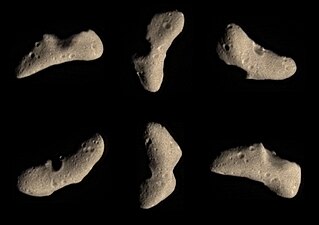In my Conworld's system, There is a porous asteroid large enough to be a dwarf planet (but it's mass is too small to pull it into a spherical shape) that has rings. How they got there, nobody knows. But could they have a prolonged orbit around the body without interference, unless from another asteroid?
-
$\begingroup$ Dwarf planets are necessarily round.. $\endgroup$– The Square-Cube LawCommented Apr 26, 2019 at 17:33
-
$\begingroup$ @Renan That's why I said it's an asteroid $\endgroup$– Greenie E.Commented Apr 26, 2019 at 18:51
-
1$\begingroup$ You said "large enough to be a dwarf planet". $\endgroup$– The Square-Cube LawCommented Apr 26, 2019 at 18:53
-
1$\begingroup$ @Greenie E.: No, the point has not been invalidated. If the body is large enough to be round (and not distorted by e.g. tidal effects from a nearby planet, or a high rotation rate), it WILL be round. $\endgroup$– jamesqfCommented Apr 26, 2019 at 19:20
-
1$\begingroup$ @Greenie E. "A small asteroid large enough to be a dwarf planet" is an oxymoron. Astronomers know of many thousands of cataloged asteroids in our solar system. Only one, the very largest one, Ceres, has the qualification to be considered a dwarf planet and is classified as a dwarf planet. Therefore, even in other solar systems, it would be a very large asteroid - not a small asteroid - that would be large enough to be a dwarf planet. $\endgroup$– M. A. GoldingCommented Apr 26, 2019 at 19:40
3 Answers
Yup! This is possible, and a number of small bodies in the Solar System have rings:
- Haumea, a dwarf planet in the outer Solar System, was recently discovered to have rings, which lie inside its Roche limit.
- Chariklo, a very large asteroid, has two known rings.
- Chiron, another minor planet, is suspected to have rings, but these have not been confirmed.
Minor planets orbit far away from each other and have such weak gravitational fields that they are unlikely to destabilize each other, barring an extreme close encounter.
These rings will eventually dissipate, as all rings do. Viscous spreading is one culprit, and for these minor planets, the effect may be more pronounced because of the nonexistence of shepherd moons around these bodies. In at least Haumea's case, an orbital resonance provides short-term stability, but not long-term stability.
10199 Chariklo
Nature bet you to the punch. This is 10199 Chariklo [1], a Centaur astroid orbiting between Saturn and Uranus. It has a radius of 151 km. As you asked for an elongated body, I see no reason why objects like these two couldnt have the same kind of ring system. In fact the artwork shown above could be inaccurate in showing an nearlt spherical body. Many astroids and comets we visited had weird shapes.
Eros pic
Ultima Thule pic
As for the zones where the rings could exist, the rings should be within the planets roche limit [2].
$r = 2.44 * \sqrt[3]{\frac{pp}{ps}}$
$r$ = roche limit
$pp$ = density primary object (your asteroid)
$ps$ = density secondary object (this was the object ripped appart to form the ring. Assume a sphere with the density of the rock-ice mixture you desire ($3 g/cm^2$ will work as an approximation))
This should give you the roach limit for a given object. Just place the rings somewhere inside it.
[1] https://solarsystem.nasa.gov/asteroids-comets-and-meteors/asteroids/10199-chariklo/in-depth/
Two implications.
1: A body large enough to be a dwarf planet that was cigar shaped.
http://www.astronomy.com/magazine/ask-astro/2017/08/the-diameter-of-spherical-bodies
For these igneous planetesimals, the diameter needed to overcome rigid body forces and become round is about 620 miles (1,000km). The main belt asteroid Vesta is 326 miles (525km) in diameter. In its early history, Vesta’s interior was at least partially molten and may at one time have been in hydrostatic equilibrium; however, after cooling, Vesta was battered out of round by large impacts.
So something the right size that is not round has either been "battered out of round" like Vesta, or is of a composition such that it is much less dense than typical asteroids - maybe porous, like Hyperion. Or hollow...
2: An object with low mass might retain a ring thru electrostatics instead of (just) gravity. Electrostatics are relevant for existing planetary rings. Fast moving dust comprising the ring might be attracted by a combination of electrostatic attraction and gravity, and so persist around this lightweight cigar-shaped planetlet.



